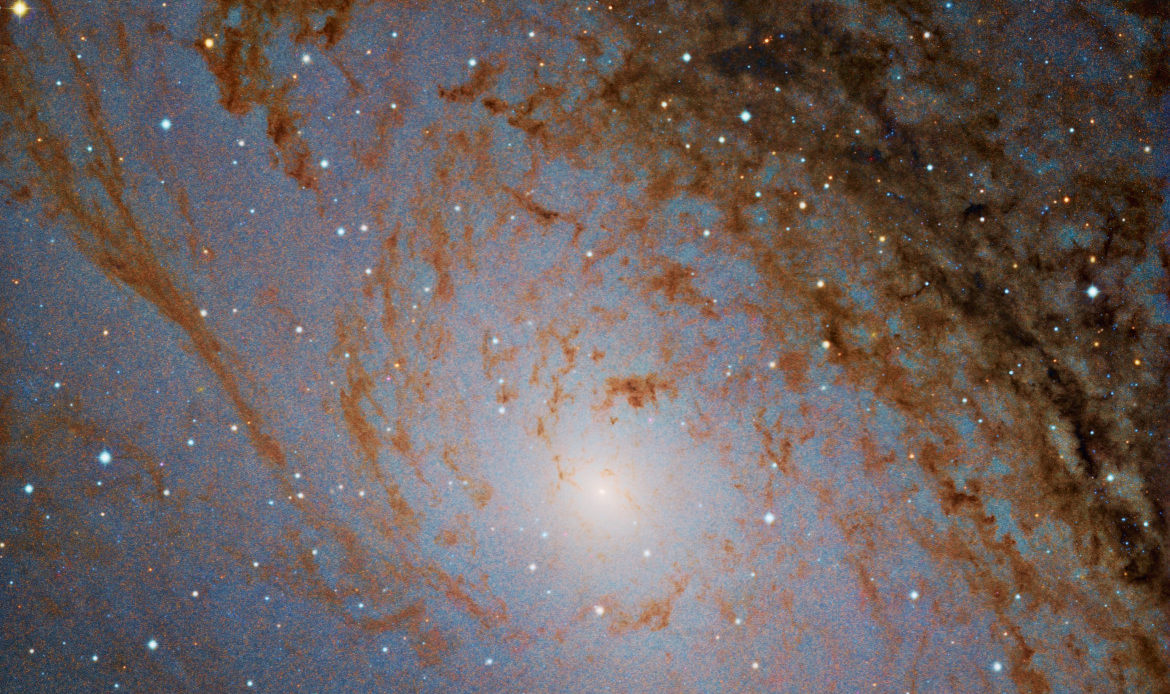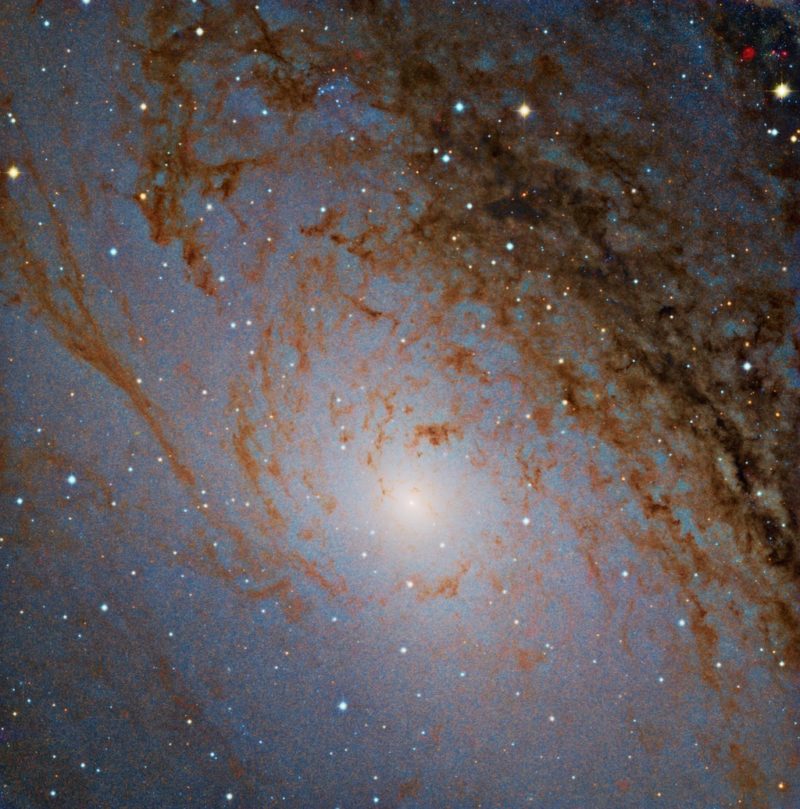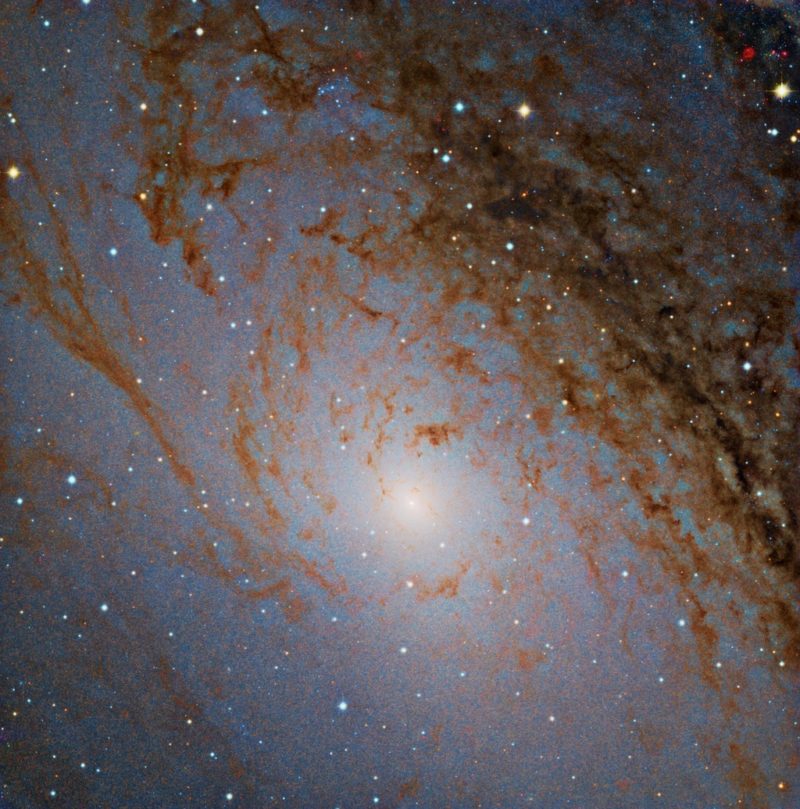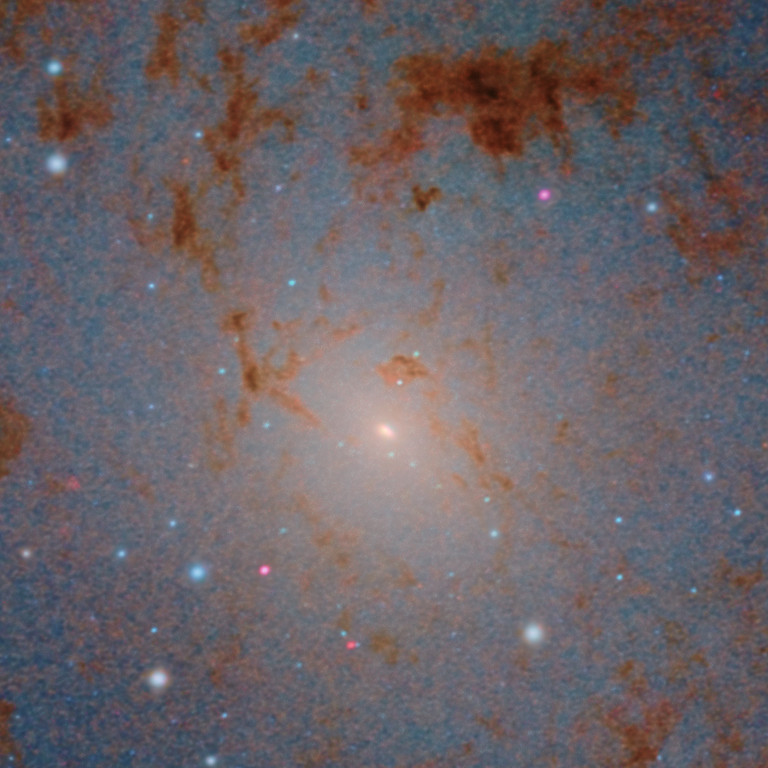Our Neighbour Andromeda Versión en español

The Andromeda galaxy is, under normal conditions, the farthest object the human eye can see without optical aid. The light that arrives today from this celestial object started its journey even before the very first humans looked up to the sky and started to wonder what could that elongated blur that they saw during dark nights be. During that journey of more than two million years, we have had time to learn that this bright cloud is a sister galaxy, our closest island universe. Here we are presenting an image of the Andromeda galaxy obtained with telescopes and instruments from the Calar Alto Observatory, which illustrates the typical phenomena that occur in a normal spiral galaxy, perhaps presenting a similar scenario as if we were to look at our own Galaxy from far away.
M31, the Andromeda galaxy
The Sun is a regular star that lives in this region of the universe with more than one hundred billion stars of all kinds that, mixed with interstellar gas and dust, form our Galaxy: a flat circular structure with a diameter of a hundred thousand light-years, crossed by spiral arms formed by bright young stars. The fact this is how the Galaxy is, may not be so obvious at a first glance. From the location of the Sun at the centre of this huge wheel, the Galactic disk appears as seen edge-on, projected against the sky background as a hazy trail, the Milky Way. Interstellar dust is accumulated in the Galactic plane and contributes to obstruct the view, because it blocks the farther away areas of the Galaxy, one of which being dense regions of the Galactic centre. What is the global real aspect of the Galaxy? Maybe we could get a better idea if we observe objects that are similar.
We know billions of galaxies, of very different types. The external galaxies that are closest to ours are its satellites, the Magellanic Clouds, two small stellar systems of the irregular type that can only be seen from Earth’s southern hemisphere. The third system in order of distance is the Andromeda galaxy, also known as M 31 or NGC 224. This is a regular spiral that has many similarities to the island universe we inhabit. At 2.54 million light-years away, it is large, close and bright enough to be seen with the naked eye under skies reasonably dark. This is usually the most distant object accessible to human vision. To get an idea of the appearance of our Galaxy as seen from the outside, we just need to turn our eyes to that faint spot between Andromeda and Cassiopeia any night during the northern fall, under skies free of light pollution.
To capture more detail, a telescope should be used. We see then that, as our Galaxy, M31 also has two satellites, although in this case they are two elliptical dwarf galaxies. The spiral disk appears under an oblique angle, which gives the Andromeda galaxy a rather elongated profile. The central part is brighter and bulkier: that is the region occupied by the bulge, a spheroidal agglomeration of redder and older stars than the ones that are present in the spiral arms. Images taken with professional telescopes that accumulate light for long integration times show that our neighbour Andromeda consists indeed of individual stars and dust mixed with gas. By observing this galaxy from the outside we access all the phenomena that occur in a regular spiral galaxy. The image presented here, obtained with telescopes and cameras at Calar Alto Observatory, is good proof of that.
The Image
The picture covers a sky area equivalent to half the width of a full Moon (about fifteen minutes of arc) and includes only the central regions of the Andromeda galaxy: the central bulge where we can see the thick and shiny core. One can also see in the image the start of the spiral structure of the disk, in the form of dark trails of dusty material. When we take a more detailed look, we can perceive a granular structure that does not correspond, as it might appear at first, to the noise or «grain» of the picture. On the contrary, the image is so detailed and deep that we can perceive the individual brightest stars that form the Andromeda galaxy. You can count individual stars from the edges of the image until almost the central region, where the stellar density becomes so high that the texture is no longer granular and, instead, it becomes a continuum of soft light. Behind a number of bright stars located in the foreground, that belong to our Galaxy, the diversity of the Andromeda spiral unfolds in front of our eyes as if it were a Persian rug: bands of dust frame specific pink regions of star formation, and giant stars appear with their true colours: blue, white or orange.
Some of the most outstanding objects have a distinguishing teal hue. They represent the brightest planetary nebulae in our neighbouring galaxy, the nebular results from the death of stars like the Sun. At the end of their existence, lightweight stars eject their outer layers and are reduced to white dwarfs. The resulting nebulosity glows with the typical teal hue of the oxygen produced during millions of years inside the stars.
Moreover, around the densest part of the bulb of M31 there are three points of light that we wouldn’t see if we were observing the same area of the sky today. They are three star bursts, three novae that appeared almost simultaneously in August 2009, when most of the data for this image were collected. Their pink colour is due to the strong emission in the blue region of the visible spectrum and the red hydrogen alpha line. The view of the Andromeda galaxy from the outside allows us to detect and study almost all novae that explode in it, contrary to what happens to novae that occur in our own Galaxy, most of which is hidden by the extinction due to Galactic nebulae.
Digging into the Andromeda galaxy with this degree of detail is similar, in some ways, to scrutinize our own Galaxy placed on the slide of a colossal microscope. The nucleus, interstellar dust, the entire range of stellar types represented by thousands of stars, the birth and death of stars, cataclysmic explosions … This photograph freezes a moment in the past, the state of the nearest spiral galaxy to our own, several million years ago. Perhaps around some of these stars there is now a telescope pointed toward our Galaxy and capturing a snapshot of what happened here long before the first woman was born.
In order for all this array of details to appear in the photograph, careful planning of the observations is required, as well as collecting light for a long time under a sky of the highest quality and, then, applying a treatment that preserves all the information present. The challenge of this picture is, on the one hand, to capture and translate at the same time the entire dynamic range of brightness that goes from the most intense stars and the nucleus of the galaxy to regions obscured by dust, and todo so while retaining all the chromatic information that reveals the nature of each object. On the other hand, the fact that the instruments and the atmospheric conditions allow us to resolve the brightest stars in the galaxy implies that increasing the resolution of the image by using computer-based techniques is a crucial step in the processing of the data.
The planning of the observations as well as the data post-processing, was the responsibility of the Documentary School of Astrophotography (DSA). The image includes data obtained during 45 minutes of integration with the Zeiss reflector telescope, with an aperture of 1.23 m, in time donated by the Fundación Andaluza para la Divulgación de la Innovación y el Conocimento, Fundación Descubre (Andalusian Foundation for Dissemination of Innovation and Knowledge, Descubre Foundation). Another 45 minutes were added from the Zeiss reflector, with 3.5 m in diameter, equipped with the LAICA camera, executed during an interval when the atmospheric conditions did not allow for capturing scientific data. Observations with the 1.23 m reflector were made with R, G and B filters, while observations with the 3.5 m reflector were made with four filters from the ALHAMBRA project, centred at 458, 489, 551 and 644 nm.
Detecting line emission objects

Some mission line objects (planetary nebulae and nova explosions) are marked in this comparison image
To highlight the comparison of objects having emission lines in their spectra, a technique developed by Spanish astronomer Fernando Ballesteros (OAUV) was used, through which one could calculate the theoretical emission in a particular wavelength (i.e. in a specific colour) from the intensity observed in two other wavelengths. The data set obtained with the ALHAMBRA filters includes four regions of the spectrum strategically selected, so that two of them (around 458 and 551 nm) do not include strong emission lines, while the other two (those of 489 and 644 nm) encircle line emission typical of oxygen, hydrogen and nitrogen. From the images of 458 and 551 nm we can calculate the expected thermal emission for the objects in the 489 and 644 image; any object that emits more than what it should upon this calculation must display one of two phenomena: either it is not a star, or it is a star with emission lines. This makes it possible to detect all objects within the galaxy containing emission lines; in this case, outbursts of novae and planetary nebulae.
Download the images
Image crdits: Calar Alto, Descubre Doundation, DSA, OAUV, Vicent Peris (OAUV), Jack Harvey (SSRO), Steven Mazlin (SSRO), Gilles Bergond (Calar Alto).
Image of the central region of M31 from the Documentary Photographic Gallery of Calar Alto Observatory (full width, no emission line enhancement).
Image of the central region of M31 from the Documentary Photographic Gallery of Calar Alto Observatory (full width, with emission line enhancement).
Enlargement of the nucleus of M 31.
Comparison of the versions witthout and with emission line enhancement (planetary nebulae and nova explosions are marked).
Text: David Galadí-Enríquez
English translation: Rogelio Bernal Andreo




